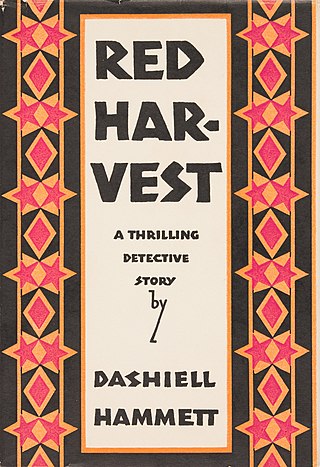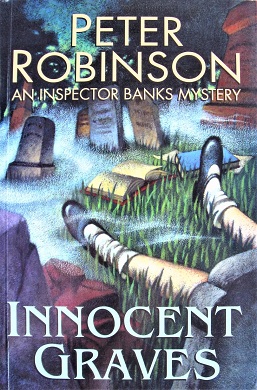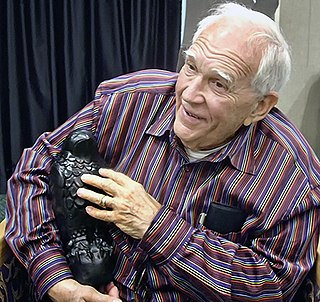Related Research Articles

A whodunit is a complex plot-driven variety of detective fiction in which the puzzle regarding who committed the crime is the main focus. The reader or viewer is provided with the clues to the case, from which the identity of the perpetrator may be deduced before the story provides the revelation itself at its climax. The investigation is usually conducted by an eccentric, amateur, or semi-professional detective.

William Chester Minor was an American army surgeon, psychiatric hospital patient, and lexicographical researcher.

The historical mystery or historical whodunit is a subgenre of two literary genres, historical fiction and mystery fiction. These works are set in a time period considered historical from the author's perspective, and the central plot involves the solving of a mystery or crime. Though works combining these genres have existed since at least the early 20th century, many credit Ellis Peters's Cadfael Chronicles (1977–1994) for popularizing what would become known as the historical mystery. The increasing popularity and prevalence of this type of fiction in subsequent decades has spawned a distinct subgenre recognized by the publishing industry and libraries. Publishers Weekly noted in 2010 of the genre, "The past decade has seen an explosion in both quantity and quality. Never before have so many historical mysteries been published, by so many gifted writers, and covering such a wide range of times and places." Editor Keith Kahla concurs, "From a small group of writers with a very specialized audience, the historical mystery has become a critically acclaimed, award-winning genre with a toehold on the New York Times bestseller list."

Samuel Dashiell Hammett was an American writer of hard-boiled detective novels and short stories. He was also a screenwriter and political activist. Among the characters he created are Sam Spade, Nick and Nora Charles, The Continental Op and the comic strip character Secret Agent X-9.

Ellery Queen is a pseudonym created in 1928 by the American detective fiction writers Frederic Dannay (1905–1982) and Manfred Bennington Lee (1905–1971). It is also the name of their main fictional detective, a mystery writer in New York City who helps his police inspector father solve baffling murder cases. From 1929 to 1971, Dannay and Lee wrote around forty novels and short story collections in which Ellery Queen appears as a character.

Phyllis Dorothy James, Baroness James of Holland Park,, known professionally as P. D. James, was an English novelist and life peer. Her rise to fame came with her series of detective novels featuring the police commander and poet, Adam Dalgliesh.

Patricia Cornwell is an American crime writer. She is known for her best-selling novels featuring medical examiner Kay Scarpetta, of which the first was inspired by a series of sensational murders in Richmond, Virginia, where most of the stories are set. The plots are notable for their emphasis on forensic science, which has influenced later TV treatments of police work. Cornwell has also initiated new research into the Jack the Ripper killings, incriminating the popular British artist Walter Sickert. Her books have sold more than 120 million copies.

Red Harvest (1929) is a novel by American writer Dashiell Hammett. The story is narrated by the Continental Op, a frequent character in Hammett's fiction, much of which is drawn from his own experiences as an operative of the Pinkerton Detective Agency. The plot follows the Op's investigation of several murders amid a labor dispute in a corrupt Montana mining town. Some of the novel was inspired by the Anaconda Road massacre, a 1920 labor dispute in the mining town of Butte, Montana.

William Anthony Parker White, better known by his pen name Anthony Boucher, was an American author, critic, and editor who wrote several classic mystery novels, short stories, science fiction, and radio dramas. Between 1942 and 1947, he acted as reviewer of mostly mystery fiction for the San Francisco Chronicle. In addition to "Anthony Boucher", White also employed the pseudonym "H. H. Holmes", which was the pseudonym of a late-19th-century American serial killer; Boucher would also write light verse and sign it "Herman W. Mudgett".

Alice Hoffman is an American novelist and young-adult and children's writer, best known for her 1995 novel Practical Magic, which was adapted for a 1998 film of the same name. Many of her works fall into the genre of magic realism and contain elements of magic, irony, and non-standard romances and relationships.
Hardboiled fiction is a literary genre that shares some of its characters and settings with crime fiction. The genre's typical protagonist is a detective who battles the violence of organized crime that flourished during Prohibition (1920–1933) and its aftermath, while dealing with a legal system that has become as corrupt as the organized crime itself. Rendered cynical by this cycle of violence, the detectives of hardboiled fiction are often antiheroes. Notable hardboiled detectives include Dick Tracy, Philip Marlowe, Nick Charles, Mike Hammer, Sam Spade, Lew Archer, Slam Bradley, and The Continental Op.
Julian Gustave Symons was a British crime writer and poet. He also wrote social and military history, biography and studies of literature. He was born in Clapham, London, and died in Walmer, Kent.

Innocent Graves is the eighth novel by Canadian detective fiction writer Peter Robinson in the Inspector Banks series of novels. The novel was first printed in 1996, but has been reprinted a number of times since. The novel was selected by Publishers Weekly as one of the best mysteries of the year, nominated for the 1996 Hammett Prize, and won the 1997 Arthur Ellis Award for 'Best Novel'.

Leslie S. Klinger is an American attorney and writer. He is a noted literary editor and annotator of classic genre fiction, including the Sherlock Holmes stories and the novels Dracula, Frankenstein, and Strange Case of Dr. Jekyll and Mr. Hyde as well as Neil Gaiman's The Sandman comics, Alan Moore's and Dave Gibbons's graphic novel Watchmen, the stories of H.P. Lovecraft, and Neil Gaiman's American Gods.

Del Staecker is an American writer of novels, novellas, short stories and non-fiction in a number of genres, including suspense, crime, philosophical fiction, satire and memoir.

Joseph Nicholas Gores was an American mystery writer. He was known best for his novels and short stories set in San Francisco and featuring the fictional "Dan Kearney and Associates" private investigation firm specializing in repossessing cars, a thinly veiled escalation of his own experiences as a confidential sleuth and repo man. Gores was also recognized for his novels Hammett, Spade & Archer and his Edgar Award-winning or -nominated works, such as A Time of Predators, 32 Cadillacs and Come Morning.

John Katzenbach is an American author of popular fiction. Son of Nicholas Katzenbach, former United States Attorney General, Katzenbach worked as a criminal court reporter for the Miami Herald and Miami News and as a featured writer for the Herald's Tropic magazine. He is married to Madeleine Blais, and they live in western Massachusetts.
Bouchercon is an annual convention of creators and devotees of mystery and detective fiction. It is named in honour of writer, reviewer, and editor Anthony Boucher; also the inspiration for the Anthony Awards, which have been issued at the convention since 1986. This page details Bouchercon XXXVI and the 20th Anthony Awards ceremony.
The Inspector Banks series is a collection of mystery novels by Peter Robinson about Detective Superintendent Alan Banks.
The Madman of the route is the nickname given to an alleged serial killer active in Mar de Plata, Argentina from 1996 to 1999. The allegations claim that a single killer is responsible for the murders and disappearances of at least 14 prostitutes, some of which were later found raped and mutilated near highways, sometimes with words written on their bodies.
References
- ↑ "La historia del loco". Goodreads. Retrieved April 27, 2024.
- 1 2 John Katzenbach (2005). The Madman's Tale. Random House Publishing Group. ISBN 978-0-345-46482-8.
- 1 2 Almazán Morales, Betzabeth (October 19, 2021). ""La Historia del Loco": John Katzenback". NaciónMX. Retrieved April 27, 2024.
- ↑ "La historia del loco". BuscaLibre Chile (in Spanish). Chile. 2017. Retrieved April 27, 2024.
- ↑ Katzenback, John. "The Madman's Tale". John Katzenback. Books. Retrieved April 27, 2024.
- ↑ "The Madman's Tale". Kirkus Reviews. July 1, 2004. pp. Fiction. Retrieved April 27, 2024.
{{cite news}}: CS1 maint: url-status (link) - ↑ Ceciliz (2011). "La historia del loco". Lecturalia. Retrieved April 27, 2024.
{{cite web}}: CS1 maint: url-status (link) - ↑ "The Madman's Tale". Publisher's Weekley. May 3, 2004. pp. Bestsellers. Retrieved April 27, 2024.
{{cite news}}: CS1 maint: url-status (link) - ↑ Anderson, Patrick. "THE MADMAN'S TALE". The Washington Post . Retrieved 15 January 2018.
- ↑ "Hammett Prize". 2004. Retrieved April 27, 2024.
- ↑ "2005 Anthony Award (Awarded by Bouchercon World Mystery Convention)". Fiction DB. 2005. Retrieved April 27, 2024.
{{cite web}}: CS1 maint: url-status (link) - ↑ "Madman's tale: a novel". Citrus Libraries. 2004. Retrieved April 27, 2024.
- ↑ Bobowick, Kendra (2007-12-13). "Where Is The Movie At Fairfield Hills?". The Newtown Bee. Retrieved 2008-11-09.